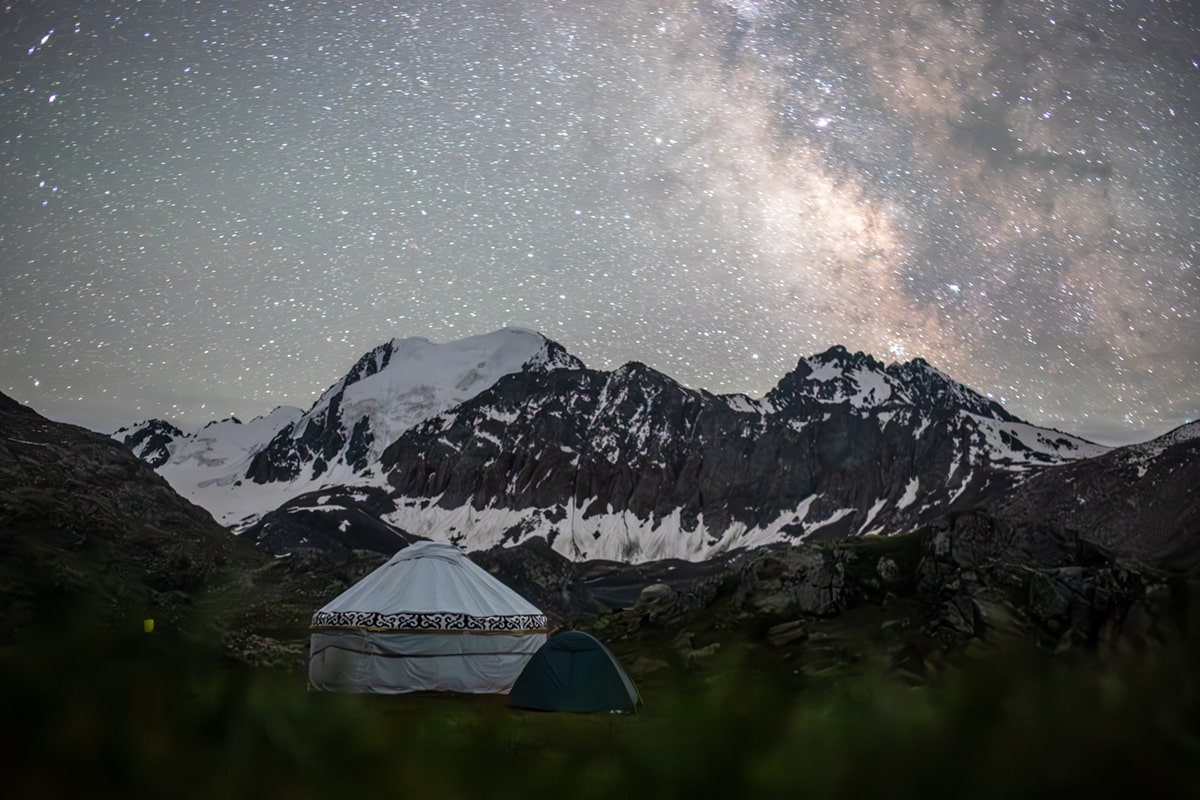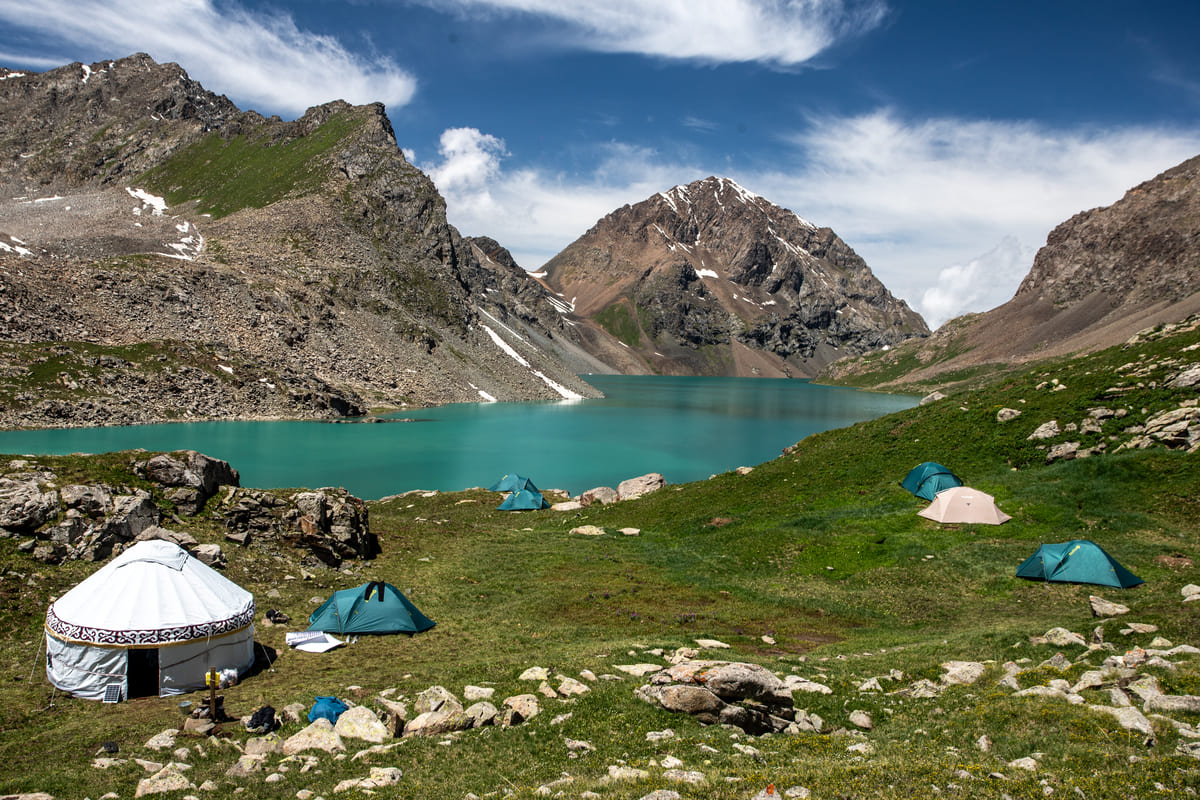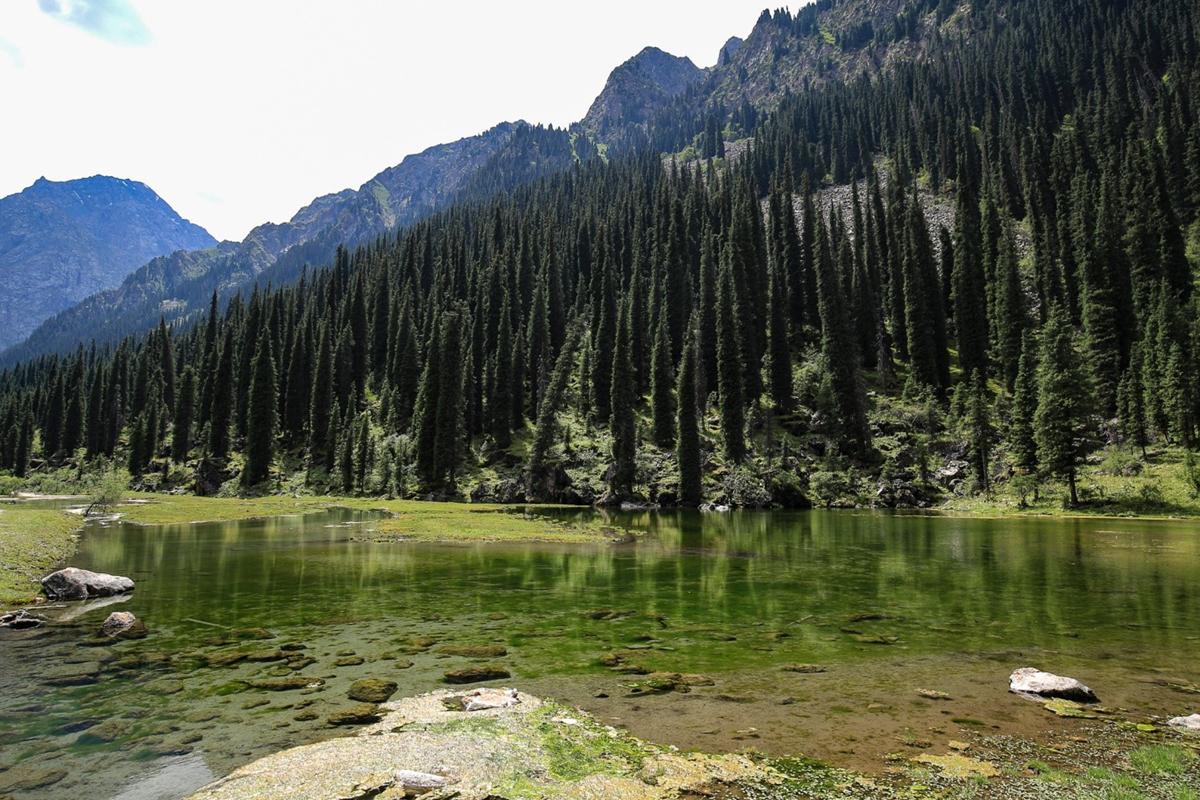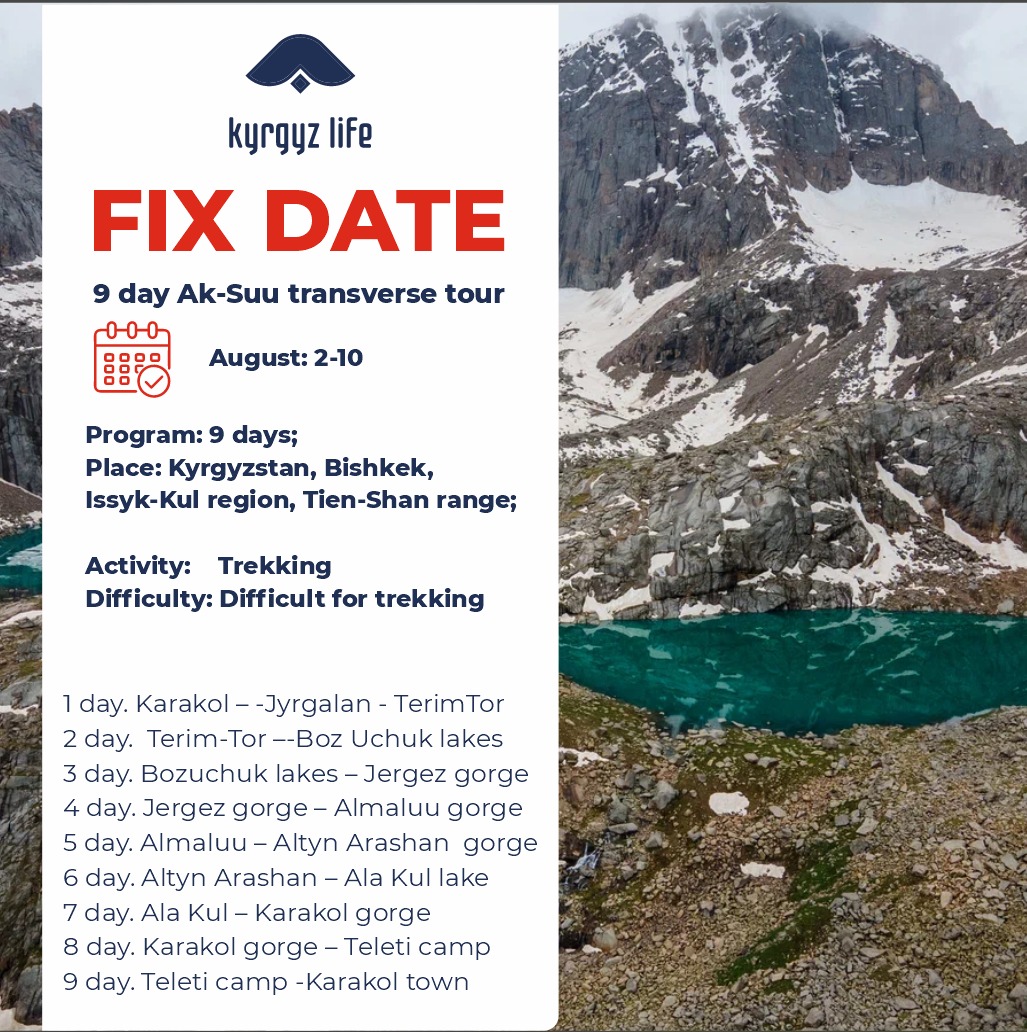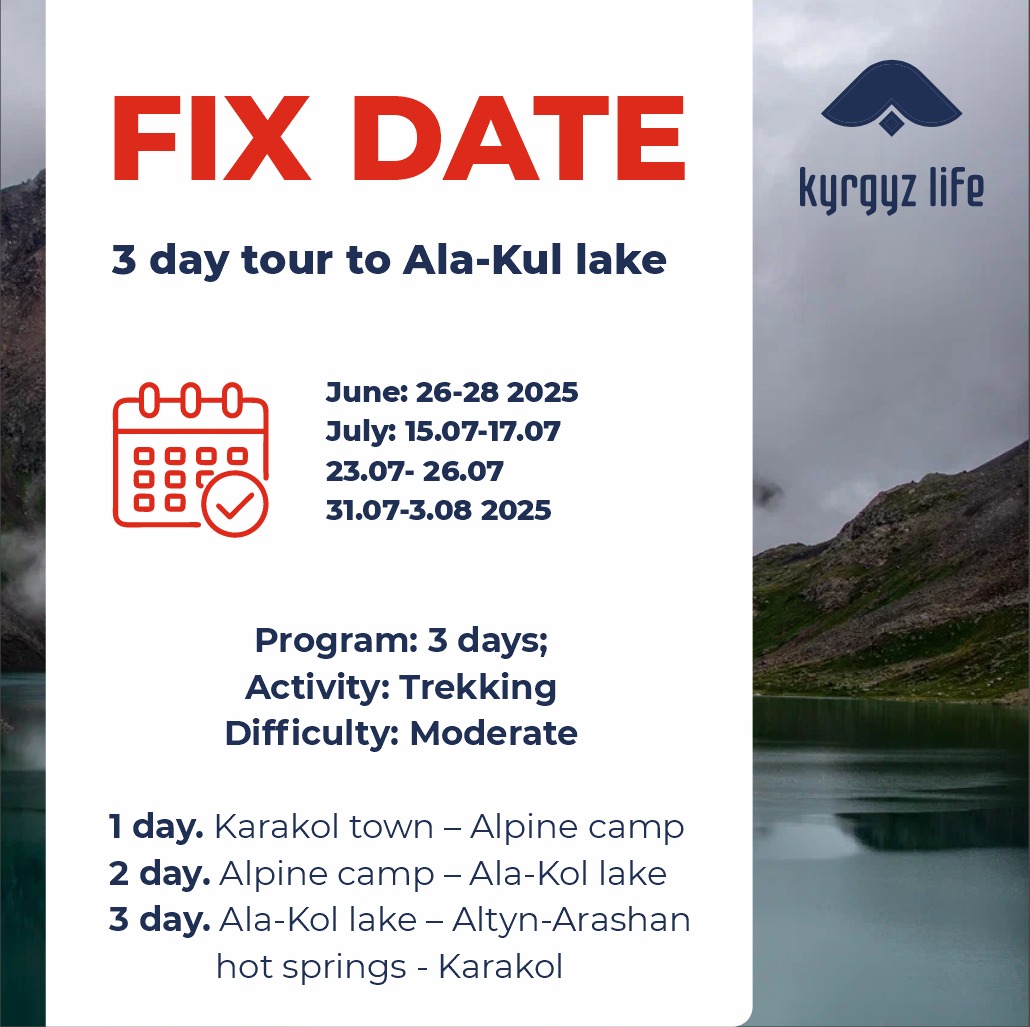4 days fixed date tour: 01 august 2025 – 04 august 2025
Overview
Duration:
Places:
Transport type:
Season:
Type of tour:
Difficulty:
Itinerary
Day 1
We depart from the city of Karakol to the Karakol Gorge in the morning.
The drive to the trail head will take about 1,5 hours. After we take our lunch bags and walk close to the foot of Karakol peak. It is 7 km one way. Usually it takes 3-3,5 hours and 2h back. Lunch.
We spend around one hour and descend back to the alpine camp. Campfire.
We divide people in to the groups and make briefing for the next day. Overnight and dinner in yurt.
Day 2
Early breakfast. Our camp and starting point at 2500m. We cross the bridge and ascend to the lake Ala-Kul lake. After about 2-2.5 hours of hiking up the valley, we will stop for rest at a small hut. After, we will continue trekking to the lake. Lunch on the route. The distance is around 12km but 1100m altitude difference. Walking till the and of the lake.
DAY FACTS
Day 3
Breakfast. From here, we must go up again toward the pass (3860m), from which you can see all of the nearby peaks of the Terskey Ala-Too ringing the lake and rising up to over 5000m above sea level. We descend the gorge to the hot springs of Altyn-Arashan (2500m). The descent takes 3-3,5 hours depending on the pace. Upon arrival, we will enjoy a relaxing soak in the hot springs. Dinner and overnigjt in guest house.
DAY FACTS
Day 4
After breakfast, we will take a gentle trip to the wild hot spings. After this, descend down the Altyn Arashan Valley toward Aksu Village. The length of the descent is 14 km, or about 3-3.5 hours. A car will be waiting for us in the village, and will drive us back to Karakol.
DAY FACTS
Included:
- Guide
- Accommodation in yurt and tent
- Transport
- Food
- Entrance fee
- Hot springs
Not Included:
- Insurance
- Alcohol
- Porters
Useful information
Clothing
- Layered Clothing: To adjust to varying temperatures, bring lightweight, breathable layers for daytime activities and warmer layers for cooler evenings.
- Waterproof Jacket and Pants: Essential for protection against rain and wind.
- Comfortable Hiking Boots: Sturdy, well-fitting boots with good ankle support are crucial for trekking and hiking.
- Warm Hat and Gloves: Even in summer, higher altitudes can be chilly.
- Swimwear: For potential swimming opportunities in lakes or hot springs.
Gear
- Daypack: A comfortable backpack for carrying essentials during daily activities.
- Sleeping Bag: While provided at camps, you may prefer your own for added comfort.
- Headlamp or Flashlight: For use in yurts, tents, and during night activities.
- Reusable Water Bottle: Stay hydrated and reduce plastic waste.
Personal Items
- Sunscreen and Lip Balm: High SPF to protect against strong mountain sun.
- Sunglasses: With UV protection.
- Personal Medications: Ensure you have enough for the entire trip.
- Toiletries: Biodegradable soap, toothpaste, toothbrush, and other personal hygiene items.
Documents and Money
- Passport and Visa (if required): Ensure your passport is valid for at least six months beyond your travel dates.
- Travel Insurance: Including coverage for trekking and horseback riding.
Miscellaneous
- Camera and Batteries: To capture the stunning landscapes and memorable moments.
- Power Bank: To charge your electronic devices when outlets are unavailable.
- Notebook and Pen: For journaling your experiences or jotting down important information.
FAQ
1.Physical Fitness: The trek involves moderate to challenging terrain with steep ascents and descents. A good level of cardiovascular fitness is important. If you regularly engage in activities like hiking, running, or cycling, you should be well-prepared.
2.Duration of Trekking: You will be trekking for several hours each day (5-6 hours on average), so it’s helpful to have endurance for sustained activity.
3.Altitude: The trek reaches elevations up to 3,650 meters (11,975 feet). If you have not hiked at high altitudes before, it may take some acclimatization, and you should be aware of altitude sickness symptoms.
4.Preparation: Prior training can help. Incorporate hikes with elevation gain into your routine, and practice carrying a daypack.
5.Consult a Professional: If you have any health concerns or pre-existing conditions, consider consulting a healthcare provider before undertaking the trek.
If you regularly engage in physical activity and are comfortable with longer hikes, you should be fit enough for this adventure!
1.Water Availability: Fresh water is usually available from natural sources along the trekking route. Make sure to refill your water bottles whenever you have the opportunity.
2.Water Purification: It’s advisable to purify water from natural sources to prevent illness. You can use water purification tablets, filters, or boil water to ensure it’s safe to drink.
3.Hydration Tips:
- Drink Regularly: Don’t wait until you’re thirsty to drink water. Aim to drink small amounts regularly throughout the day.
- Monitor Color: Check the color of your urine; pale yellow indicates good hydration, while dark yellow may indicate dehydration.
- Electrolytes: Consider bringing electrolyte tablets or powders to add to your water, especially if you’re sweating a lot.
4.Daily Intake: Aim to drink at least 2-3 liters of water daily, more if you’re sweating heavily or if the weather is hot.
5.During the Trek: Carry a refillable water bottle or hydration system in your daypack for easy access while hiking.v By staying well-hydrated, you’ll maintain your energy levels and enjoy your trekking experience more!


